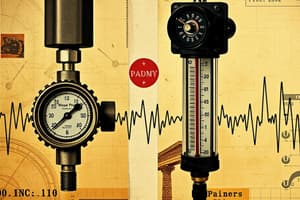Podcast
Questions and Answers
What is the main purpose of troubleshooting an electronic transmitter?
What is the main purpose of troubleshooting an electronic transmitter?
- To calibrate it
- To identify and fix problems (correct)
- To replace it with a new one
- To improve its accuracy
What is the primary focus of calibration in electronic transmitters?
What is the primary focus of calibration in electronic transmitters?
- To check for physical damage
- To verify its accuracy and precision (correct)
- To reduce its power consumption
- To improve its response time
Why is regular calibration of electronic transmitters important?
Why is regular calibration of electronic transmitters important?
- To extend its lifespan
- To comply with safety regulations
- To ensure accurate measurements (correct)
- To reduce maintenance costs
What is the primary benefit of repairing an electronic transmitter?
What is the primary benefit of repairing an electronic transmitter?
What is the relationship between troubleshooting and repair in electronic transmitters?
What is the relationship between troubleshooting and repair in electronic transmitters?
Which of the following is a key aspect of troubleshooting electronic transmitters?
Which of the following is a key aspect of troubleshooting electronic transmitters?
What is the primary goal of calibrating an electronic transmitter?
What is the primary goal of calibrating an electronic transmitter?
Which of the following is a potential outcome of neglecting to calibrate an electronic transmitter?
Which of the following is a potential outcome of neglecting to calibrate an electronic transmitter?
Which of the following is NOT a common step in troubleshooting an electronic transmitter?
Which of the following is NOT a common step in troubleshooting an electronic transmitter?
What is the relationship between troubleshooting and repairing electronic transmitters?
What is the relationship between troubleshooting and repairing electronic transmitters?
What is a key step involved in the calibration of electronic transmitters?
What is a key step involved in the calibration of electronic transmitters?
Which method is commonly used to troubleshoot an electronic transmitter?
Which method is commonly used to troubleshoot an electronic transmitter?
Which of the following tends to be a result of improper calibration of electronic transmitters?
Which of the following tends to be a result of improper calibration of electronic transmitters?
What is typically not a goal of troubleshooting electronic transmitters?
What is typically not a goal of troubleshooting electronic transmitters?
Which is a potential benefit of regularly calibrating an electronic transmitter?
Which is a potential benefit of regularly calibrating an electronic transmitter?
Which of the following is a primary objective of troubleshooting an electronic transmitter?
Which of the following is a primary objective of troubleshooting an electronic transmitter?
What is the primary purpose of calibrating an electronic transmitter?
What is the primary purpose of calibrating an electronic transmitter?
Which of the following is NOT a common step in troubleshooting an electronic transmitter?
Which of the following is NOT a common step in troubleshooting an electronic transmitter?
What is a potential outcome of neglecting to calibrate an electronic transmitter?
What is a potential outcome of neglecting to calibrate an electronic transmitter?
Which of the following is NOT a benefit of regularly calibrating an electronic transmitter?
Which of the following is NOT a benefit of regularly calibrating an electronic transmitter?
Flashcards are hidden until you start studying
Study Notes
Troubleshooting Electronic Transmitters
- Identify common issues in electronic transmitters such as signal loss or distortion.
- Utilize diagnostic tools like multimeters and oscilloscopes for troubleshooting.
- Examine wiring, connections, and components for faults or degradation.
- Understand common failure modes and symptoms for accurate diagnosis.
Repairing Electronic Transmitters
- Replace faulty components such as capacitors, resistors, or integrated circuits.
- Ensure proper soldering techniques to maintain connection integrity.
- Test transmitter functionality after repairs to confirm proper operation.
- Document any repairs and modifications for future reference or troubleshooting.
Calibration of Electronic Transmitters
- Regular calibration ensures accuracy and reliability of transmitted signals.
- Use known reference standards to adjust transmitter output.
- Follow manufacturer guidelines and specifications during calibration process.
- Conduct periodic checks to maintain calibration over time.
Importance of Calibration
- Calibration affects the precision of measurements and data transmission.
- Inaccurate transmitters can lead to operational inefficiencies and errors.
- Maintain regulatory compliance through regular calibration practices.
Troubleshooting and Repair of Electronic Transmitters
- Troubleshooting involves identifying issues within electronic transmitters that affect performance.
- Common problems may include signal loss, distortion, and failure to transmit.
- Steps for troubleshooting typically involve checking power supplies, connections, and circuit integrity.
- Use diagnostic tools like multimeters and oscilloscopes for accurate measurements and evaluations.
- Documentation of previous repairs and modifications can aid in diagnosing recurring issues.
Calibration of Electronic Transmitters
- Calibration ensures electronic transmitters operate within specified parameters to maintain accuracy and reliability.
- The calibration process usually includes adjusting settings based on a standard reference or known signal input.
- Regular calibration is essential to compensate for drift in readings due to environmental factors or aging components.
- Calibration procedures often require specific equipment, such as signal generators and frequency analyzers.
- Proper calibration intervals depend on the application, with some systems requiring frequent checks, while others may be less demanding.
Troubleshooting and Repair of Electronic Transmitters
- Electronic transmitters require routine troubleshooting to identify issues affecting performance.
- Common issues include signal degradation, incorrect output levels, and power supply failures.
- Utilizing diagnostic tools such as oscilloscopes and multimeters is essential for effective troubleshooting.
- Step-by-step procedures should be followed to isolate faults, ensuring minimal disruption to system operations.
- Repairs may involve replacing faulty components such as sensors, circuits, or wiring.
Calibration of Electronic Transmitters
- Calibration ensures that electronic transmitters provide accurate and reliable measurements.
- The calibration process involves comparing the transmitter's output with a standard reference.
- Regular calibration intervals help maintain measurement integrity and compliance with industry standards.
- Adjustment procedures vary depending on the type of transmitter and application.
- Proper documentation during calibration is crucial for maintaining a reliable history of the transmitter's performance.
Troubleshooting Electronic Transmitters
- Focus on identifying and resolving faults in electronic transmitters for effective performance.
- Common issues include signal failure, incorrect readings, and hardware malfunctions.
- Utilize diagnostic tools such as multimeters and oscilloscopes to assess transmitter functionality.
- Examine input and output signals; ensure they align with expected values.
- Regular maintenance and software updates can preemptively address potential issues.
Repairing Electronic Transmitters
- Repair procedures depend on the specific type of transmitter and identified faults.
- Components may frequently require replacement, including sensors, microchips, or power supplies.
- Follow manufacturer guidelines for disassembly and reassembly to avoid damage during repairs.
- Document all repairs for future reference and compliance with industry standards.
- Testing after repair is crucial to ensure the transmitter functions correctly and meets specifications.
Calibration of Electronic Transmitters
- Calibration is the process of adjusting and verifying transmitter accuracy against known standards.
- Regular calibration ensures that measurements remain within acceptable limits and are reliable.
- Utilize standardized calibration equipment and procedures recommended by manufacturers or industry regulations.
- Calibration intervals depend on the application, environmental conditions, and transmitter technology.
- Record calibration results, adjustments made, and any deviations from expected performance for traceability.
Studying That Suits You
Use AI to generate personalized quizzes and flashcards to suit your learning preferences.




